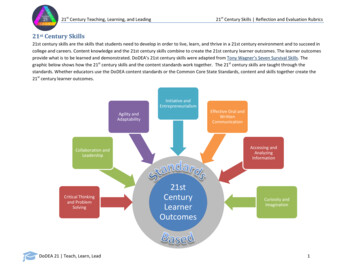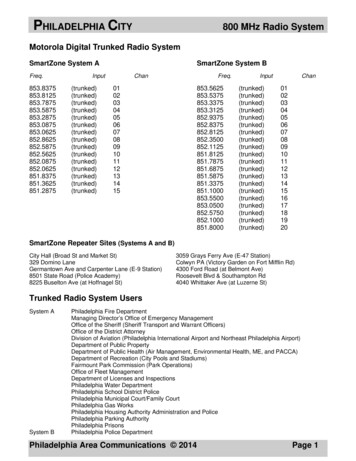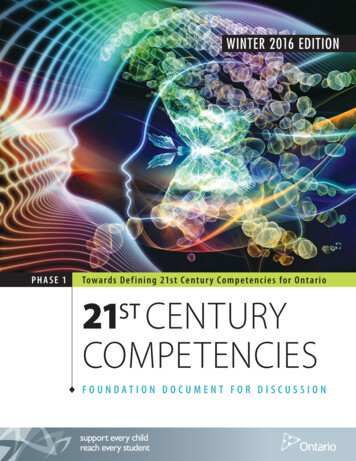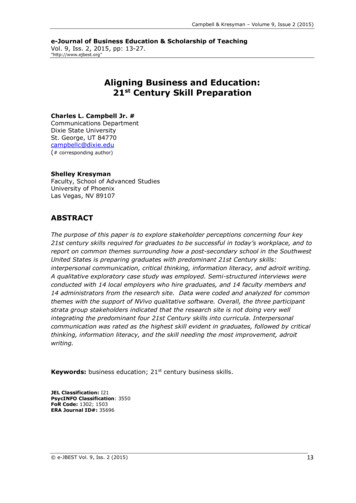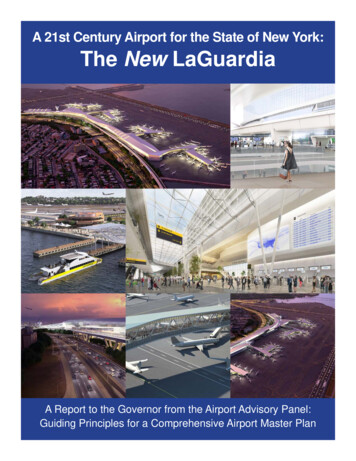
Transcription
A 21st Century Airport for the State of New York:The New LaGuardiaA Report to the Governor from the Airport Advisory Panel:Guiding Principles for a Comprehensive Airport Master Plan
Airport Advisory PanelDan Tishman, ChairAmanda BurdenTony CollinsJose Gomez-IbanezMelinda KatzJackie SnyderJohn ZuccottiAndrew Cuomo, Governor, The State of New York
July 27, 2015Dear Governor Cuomo,LaGuardia Airport plays a critical role as a gateway for the State of New York. It is responsible for nearly 12,000jobs and served nearly 27 million passengers last year. Yet its development over the years has been disjointedand sporadic. The airport today is consistently rated as among the worst airports in the world in terms of its design,delays, and overall passenger experience – a 20th century airport overwhelmed by 21st century demands.In order for the State of New York and the region to remain competitive, we must modernize and revitalize thiscritical gateway for the 21st Century, to enable us to maintain our competitiveness and maximize job creation andeconomic opportunities.In January, you appointed me to Chair an Airport Advisory Panel to advise you and the Port Authority of New York &New Jersey on the modernization of LaGuardia and John F. Kennedy International airports. The Panel did a deepdive over the last seven months in reviewing LaGuardia and its issues, and taking on your challenge to think boldlyand to develop a holistic master plan for an airport that the people of the State of New York and the region deserve.Attached is our report outlining our recommendations for a new, 21st Century LaGuardia Airport.Our recommendations were inspired by your charge to not just remodel or rebuild the existing facilities. We focusedon a comprehensive vision for the airport that has been lacking over the decades of its prior development. We put afocus on putting passengers first and improving their experience, starting with how they get to the airport. We alsoput an emphasis on how a new, modern airport can be a good neighbor to the people of Queens by reducing trafficand expanding job opportunities.As Governor, you have consistently emphasized that we must get government moving, and deliver real results forthe people of the State of New York. Towards that end, our report contains specific recommendations including nextsteps to ensure that this vision can be translated into an implementable master plan.We thank you for the opportunity to serve, and look forward to seeing the vision of a new LaGuardia become areality.Sincerely yours,Dan TishmanOn Behalf of the Airport Advisory PanelCC:John Degnan, Chairman, Port Authority of New York & New JerseyScott Rechler, Vice-Chairman, Port Authority of New York & New JerseyBoard of Commissioners, Port Authority of New York & New JerseyPatrick Foye, Executive Director, Port Authority of New York & New JerseyAmanda BurdenTony CollinsJose Gomez-IbanezQueens Borough President Melinda KatzJackie SnyderJohn Zuccotti
Executive SummaryWhen Terminal B at LaGuardia Airport(“LaGuardia”) first opened in 1964, it wascalled “the air gateway to America” and“the crossroad of the world.” Now known as a “thirdworld country” airport, LaGuardia is synonymouswith cramped, dilapidated facilities ill-equipped tomeet the demands of today, much less the demandsof the future. For far too long, LaGuardia has beensubjected to underinvestment and sporadic andpiecemeal development with no overarching vision orplan on what the airport should be. The recommendations from Governor AndrewCuomo’s Airport Advisory Panel (“Panel”) will endthe disjointed development that has long plaguedthe airport and will provide the guiding principles fora holistic master plan for LaGuardia. The Panel’srecommendations call for more than just “brick andmortar” improvements; they call for the developmentof an airport that puts the passenger first and providesan experience befitting the State of New York.automated tram to provide passengers with easiermovement between the airport’s terminals;Business and conference center capabilities tomeet the needs of the business traveler and localbusinesses;A sustainable and resilient airport that minimizesenergy consumption, reduces harmful emissions,and protects critical infrastructure to keep theairport operational during a flood event;A design that accommodates a potential hotel, aswell as future growth at the airport;andA Marine Air Terminal that is better integrated withthe main airport via an automated tram or someother form of reliable and convenient mode oftransportation.The Panel’s recommendations for the new airportinclude the following elements:New ways to access the airport, including: An airport designed to accommodate a futureAirTrain; Ferry service to the Marine Air Terminal and, iffeasible, to the east end of the airport; and Improved road configuration that will reducecongestion on the surrounding roadway network,including the Grand Central Parkway.Airport Recommendations: Demolish Terminal B and thoroughly redevelopTerminals C and D to build a unified airport terminalto form a complete, efficient, and appealingexperience for passengers; Build the new unified terminal closer to the GrandCentral Parkway coupled with an island-gatesystem that will create nearly two miles additionalaircraft taxiways for better aircraft circulationand reduce gate delays that are frustrating forpassengers and expensive for airlines; Appealing and significant terminal architecturewith high ceilings, expansive natural lighting, andopenness, designed so passengers intuitivelyunderstand the airport’s layout; An “airport of tomorrow” that embraces cuttingedge technology and includes best-in-classamenities; An Airport People Mover (APM) such as anConsideration for the Queens Community An adequate and accessible cell phone lot waitingarea so cars and vans can wait at the airport to pickup arriving passengers instead of on neighborhoodstreets; Adequate parking capacity to ensure thatsurrounding neighborhoods and roadways are notused for airport parking; Consolidation of the ten rental car companies inand around the airport into a single facility either at,or within close proximity to, the airport; Extensive employment opportunities for theBorough of Queens, including increasedparticipation by Minority and Woman owned andAirport Concession Disadvantaged BusinessEnterprises (M/WBE, ADCBE) in line with theGovernor’s goal of 30% MWBE participation; and Expansion of the Port Authority’s Aircraft Noiseprogram as appropriate throughout construction.A 21st Century Airport for the State of New York: the New LaGuardiaPage 1
Ensuring Accountability and Progress Retaining a Master Planning Firm to advise thePort Authority and the Governor, to translate thePanel’s recommendations into an implementablemaster plan, and to coordinate airport developmentfor the long-term; and Establishing a new Port Authority Board Committeeto oversee airport development and implementationof the master plan.This report addresses LaGuardia Airport due to theunique nature of the airport, as well as the immediateneed to synchronize the Panel’s recommendationswith the pending public private partnershipconstruction project.The Panel will issue recommendations concerningJohn F. Kennedy International Airport in the future.A 21st Century Airport for the State of New York: the New LaGuardiaPage 2
IntroductionFrom the Erie Canal and New York State’s historicParkways, to the Brooklyn Bridge, the TappanZee Bridge and the New York City subwaysystem, New York State is home to some of the mostcritical infrastructure in the United States. The EmpireState is often defined by its rich history of construction,and the infrastructure built in the last century has servedas a foundation for the success that New York enjoystoday. The continuation of that success depends onour ability to adapt to the ever-evolving demands of the21st century economy. As Governor Andrew Cuomonoted, these demands are often stymied by 20th centuryinfrastructure. However, large construction projectsthat many have dismissed or ignored because they aretoo challenging to undertake can be overcome, as theGovernor has demonstrated with the replacement of theTappan Zee Bridge.New York’s airports, particularly LaGuardia and John F.Kennedy International Airport (“JFK”), are no exception.Both airports play a critical role for the State of NewYork, but these facilities are unable to meet the demandsof today, much less the needs of the future. Together,LaGuardia and JFK host an estimated 80 milliontravelers a year, directly provide nearly 50,000 jobs andsupport more than 50 billion in economic activity inthe region. Yet, many of the terminals at these airportswere built more than 50 years ago during a different erain aviation travel and have not kept pace with today’spassenger demands.LaGuardia and JFK have been consistently rated amongthe worst airports in the world in terms of design andoverall passenger experience. Skytrax, an independentfirm that conducts international passenger surveys ofthe world’s airports, placed JFK 60th in its list of the top100 airports in the world and LaGuardia failed to evenmake the list of the top 100. Frankly, it does not requirean international passenger survey to recognize thecondition of New York’s airports, particularly LaGuardia.As Vice President Joe Biden candidly noted, “If Iblindfolded you and took you to LaGuardia Airport inNew York, you would think, ‘I must be in some thirdworld country.’ ”In order for New York and the region to remaincompetitive, we must rebuild and revitalize these criticalinternational gateways for the 21st century economy.In January 2015, Governor Cuomo created a sevenmember Panel to advise the Governor and the PortAuthority of New York and New Jersey (“Port Authority”)on the modernization of LaGuardia and JFK airports toreturn these once great airports to the position that theydeserve. These modernization efforts should moveforward with the goal of delivering 21st century airports tothe State, while maximizing job creation and economicopportunities throughout Queens and the region.The Governor’s airport advisory Panel is comprised ofthe following members:Dan Tishman, Chair – Vice chairman at AECOMTechnology Corporation and Chairman and CEO ofTishman Realty and ConstructionAmanda Burden – Former New York City PlanningCommissioner and a current principal at BloombergAssociatesTony Collins – President of Clarkson University,co-chair for the North Country Regional EconomicDevelopment Council, president of the SeawayPrivate Equity Corporation, and a member ofNYSERDA’s Technology & Market DevelopmentAdvisory CommitteeJose Gomez-Ibanez – Derek C. Bok Professorof Urban Planning and Public Policy at Harvard’sKennedy School of Government and Harvard’sGraduate School of DesignQueens Borough President Melinda KatzJackie Snyder – Special advisor for infrastructurefor New York State and the former head of the NYCDesign CommissionJohn Zuccotti – Co-chairman of Brookfield OfficeProperties and chairman of the board of directors ofBrookfield Financial Properties LLCA 21st Century Airport for the State of New York: the New LaGuardiaPage 3
In 1964, LaGuardia was called ‘the air gateway to America . . .’A 21st Century Airport for the State of New York: the New LaGuardiaPage 4
. . . today it’s been likened to a ‘third-world airport.’A 21st Century Airport for the State of New York: the New LaGuardiaPage 5
Profile of LaGuardia Airportpened in 1939, LaGuardia borders Flushingand Bowery bays in the northwestern sectionof Queens, NY, and has been operated bythe Port Authority under a lease agreement with theCity of New York since 1947. Today, nearly 12,000employees work at the airport serving nearly 27 millionpassengers, making LaGuardia the 20th busiest airportin the country. The airport contributes approximately 16.3 billion in economic activity to the region,generating about 121,000 total jobs and 5.9 billion inannual wages.OTwelve airlines serve nearly 70 non-stop destinationsfrom 73 gates spread across four passenger terminals:Terminal A – Currently known as the Marine AirTerminal, the terminal was designated as a historiclandmark in 1995 and serves nearly one millionpassengers annually. The terminal has six aircraftgates and is over a mile from the main airport.Terminal B – Opened in 1964, Terminal B has 35aircraft gates, serves eight airlines, and accounts forabout half of the airport’s total passengers.Terminal C – Opened in September 1992, Terminal Cincludes 22 aircraft gates operated by Delta Air Lines.Terminal D – Constructed in June 1983 by Delta AirLines at the east end of the airport, Terminal D has10 gates and is connected by a pedestrian bridge toTerminal C.Master Plan Design CompetitionIn October 2014, Governor Cuomo announceda master plan design competition for LaGuardiaand JFK Airports to generate a vision on howto transform and modernize them for the 21stcentury. The Panel reviewed six submissions forLaGuardia that included a number of innovativeconcepts related to transportation access andoverall airport design, which helped inform thePanel’s final recommendations. The Panel narrowed down the field to three designs and hasrecommended that the contestants responsiblefor these designs1 receive a one-time 250,000payment for their work related to the design competition.1SHoP Architects; Dattner Architects, and PRESENT Architecture PLLCA 21st Century Airport for the State of New York: the New LaGuardiaPage 6
Guiding PrinciplesFor a Comprehensive Airport Master PlanAirport RecommendationsA Single, Unified AirportLaGuardia should look and feel like a single, unifiedterminal both from within and outside the airportcomplex. The airport should form a complete, efficientand appealing experience for passengers, with aconsistent aesthetically pleasing facade worthy of aworld-class airport serving one of the world’s premiercities. Such a design should be viewed as a singleairport complex with a visually attractive presencealong the Grand Central Parkway.The first phase of this unification experienceshould begin with the demolition of Terminal B andthe construction of a new and larger 21st Centuryterminal with a new central departure and arrivalshall (central hall) located between the new terminaland Terminal C, linking the two terminals for thefirst time. Passengers arriving via a future AirTraincan disembark directly into the new central hall withits views of the airfield, affording passengers anappealing entry into the airport.Airside ImprovementsThe airport’s current taxiways consistently operateat capacity during peak travel times, which resultsin increased gate delays that are frustrating forpassengers and expensive for airlines. The Panelrecommends moving the airport terminals closer tothe Grand Central Parkway and adopting an islandgate system in which passengers access gates via apedestrian bridge connecting the terminal headhouseto the gate area. This will enable the construction ofadditional taxiways underneath the bridges, whichwould improve aircraft circulation, reduce taxi-in andtaxi-out times, reduce gate delays, and decreaseharmful carbon emissions from idling aircraft.Starting with the new Terminal B and Central hall,moving the terminal 600 feet closer to the GrandCentral Parkway and adopting an island-gate systemwould increase taxiway circulation from 4,594 feet/0.9miles to 11,026 feet / 2.1 miles – an increase of2.4x compared to the existing terminal. With theredevelopment of Terminals C and D, moving thesefacilities closer to the Grand Central Parkway wouldyield a total taxiway increase of nearly two miles.These gains should improve overall airport efficiencyThe Panel recommends that the Port Authoritysupport and encourage Delta’s strong desire tothoroughly redevelop Terminals C and D in parallelwith the construction of the new Terminal B andCentral Hall. The overall terminal design shouldfollow the recommended framework of creating acontinuous and unified airport.A 21st Century Airport for the State of New York: the New LaGuardiaPage 7
as aircraft can start up at any gate and have theflexibility to taxi in multiple directions.LaGuardia Airport is also the only major airport inthe region that does not provide non-stop service tothe west coast. Due to a perimeter rule establishedby the Port Authority in 1984 to grow Newark LibertyInternational and JFK airports, flights into and out ofthe airport are limited to only 1,500 miles, with certainexceptions. The Port Authority is currently evaluatingthe impact (in regards to airport operations andpassenger experience, as well as environment, noiseand other issues) in modifying or lifting this rule. ThePanel recommends that the physical redevelopmentof the airport be carried out in a manner to be ableto accommodate appropriate aircraft in the event thePort Authority Board amends the existing perimeterrule in the future.tomorrow” that can adopt and embrace innovationsin technology that enhance passenger experience.Examples of these technological improvementsinclude automated check-in, self service bagcheck-in, facial recognition and other technology toenhance and expedite security, and apps that providepassengers will real-time information on flight status,retail, dining, and entertainment options on-airport, aswell as in Queens and throughout New York City.New York is also home to some of the best dining andshopping experiences in the world and the new airportshould be no exception. From global retail names tosmall, local, “only in New York” establishments, theairport should provide passengers a best in-classretail and dining experience that is worthy of, andunique to, the State of New York.Passenger-first Airport ExperienceWith best in-class amenitiesPassengers at the new airport should intuitivelyunderstand the layout of the airport and where theyneed to go upon entering the terminal and centralhall. The airport should be designed with generousheight and openness to ensure a sense of orientationfor passengers and facilitate efficient movementthroughout the airport.Airport People MoverToday more than four million of LaGuardia’spassengers connect to other flights at the airport.This number will only increase organically withthe continued growth of air traffic. The number ofconnecting passengers could increase further if thePort Authority were to amend its perimeter rule forLaGuardia, which limits the distance of flights toand from the airport to only 1,500 miles, with certainexceptions.The redesigned airport should be an “airport ofThe new airport should include an Airport PeopleA 21st Century Airport for the State of New York: the New LaGuardiaPage 8
Mover (APM), such as an automated tram, to movepassengers throughout the airport in a convenientand accessible manner. The Panel recommendsthat future development provide optionality for a newAPM and recommends the Port Authority conduct acomprehensive study to determine the best APM systemfor the airport. The type and size of the APM should bebased on anticipated passenger demand.Business and Conference Center CapabilitiesAnd HotelWith more than 40 percent of passengers travelingfor business purposes, the new airport should includebusiness and conference center capabilities to meetthe needs of its business-travelers, as well as localbusinesses that may want to utilize the services andamenities.Common in most world-class airports, a boutique hotellocated in the airport’s new central hall would providepassengers with a convenient overnight option andconference facilities. The Port Authority should evaluatethe merits of a 200-room boutique hotel to determinethe hotel’s potential contribution to the overall passengerexperience, the anticipated revenue generated by thehotel, and how it can be developed and branded in away that complements rather than competes with thehotels nearby.Marine Air TerminalThe Marine Air Terminal serves a small but integral roleat LaGuardia with nearly one million passengers passingthrough the terminal each year. However, the Marine AirTerminal is over a mile from the main airport requiringpassengers connecting to flights at other terminals at theairport to do so by car, bus, or airport shuttle.While the Panel reviewed a number of alternative usesfor the Marine Air Terminal, such as a new museumand other civic programs, it concluded that the terminalshould remain an aviation facility in light of LaGuardia’slimited footprint and the anticipated increase inpassengers. However, it should be modernized in thesame manner as the rest of the airport and it should bebetter integrated with the main airport via an automatedtram or some other form of reliable and convenientmode of transportation, based on anticipated passengerdemand.A 21st Century Airport for the State of New York: the New LaGuardiaPage 9
Access to the AirportFuture Rail ConnectionLaGuardia is the only major airport in the New YorkCity region that is not accessible by rail. The NewYork Metropolitan Transportation Authority (MTA)has made a number of efforts to increase publictransportation to and from the airport by select busservice, express bus service, and regular bus service.However, none of these options are as efficient andreliable as rail service. Passenger demand for rail tothose airports that provide AirTrain service has donenothing but continue to increase. Since the AirTrainopened at JFK in 2003, ridership has increased 247percent and last year saw a record ridership of 6.5million passengers. At Newark Liberty InternationalAirport, AirTrain ridership has increased by 137percent since it was introduced in 2001.Ferry ServiceIn 1987, Pan Am started a water taxi service fromWall Street (Pier 11) to the Marine Air Terminal. DeltaAir Lines acquired the service and operated it until2000. Since that time, with faster and more efficientwatercraft, ferry service has become a more viableform of transportation.The Panel supports Governor Cuomo’s vision to bringrail service to LaGuardia from Willets Point. However,given the densely populated communities surroundingthe airport, the Panel recommends that the PortAuthority and the MTA work with the community toconduct the necessary evaluation and planning todetermine the best method and route for rail service toLaGuardia that minimizes community impacts. In theinterim, the Panel recommends that the Port Authorityand the MTA expand upon existing service suchas the M60 and Q70 bus service to increase publictransportation access to LaGuardia.Improved Road ConfigurationThe redevelopment of the airport presents anopportunity to address the confusing and inefficientroad configuration, which results in inconveniencedpassengers and increased congestion on both localroads and the Grand Central Parkway. The Panelrecommends that the Port Authority develop a moreefficient roadway configuration to improve trafficflow at the airport and reduce congestion on thesurrounding roadway network, including the GrandCentral Parkway, and, more importantly, on residentialstreets.The Panel recommends that the Port Authorityexplore a strategy for a ferry service operation to theMarine Air Terminal and, if feasible, to the east end ofthe airport as well. With the potential of integratingthe Marine Air Terminal via an automated tram, thenew ferry service would provide passengers withadditional transportation options to travel to theairport.A 21st Century Airport for the State of New York: the New LaGuardiaPage 10
Community Issuesore than 600,000 residents live nearLaGuardia and approximately 50 schools arelocated within five miles of the airport. Asimportant as it is that LaGuardia become an airportfor the 21st Century, it is just as important that the PortAuthority remain a good neighbor to the communitythroughout construction. In addition to the aestheticbenefits of a new, modern airport, the Panel hasprovided a number of recommendations to improve thequality of life for the communities surrounding the airportand the Borough of Queens:MCell Phone Lot Waiting AreaUnlike most airports, including JFK and Newark LibertyInternational Airports, LaGuardia does not have anadequate cell phone lot for individuals waiting to pick uparriving passengers. As a result, cars and vans cloglocal streets and the Grand Central Parkway to wait forarriving passengers. The Panel recommends that aspart of the modernization of LaGuardia the Port Authorityidentify a location for an adequate and accessible CellPhone Lot Waiting Area at the airport.ParkingThe Port Authority is currently constructing a new1,100-space parking garage on the east end of theairport, and a new 3,100-space parking garage will becarried out by the public- private partnership for theconstruction of the western half of the main airport. ThePanel recommends that the Port Authority conduct athorough analysis of the number of parking spacesneeded to ensure an adequate level of parking such thatthe surrounding neighborhoods are not used as parkingfor the airport. Parking garages should be locatedwithin easy access to the Airport People Mover or withinwalking distance to the terminals. The new parkinggarages should also be incorporated into the overallarchitecture to ensure a unified design treatment of theentire airport complex.Consolidated Car RentalThere are currently ten car rental companies that serveLaGuardia, but only two of these companies are located onthe airport. The Panel recommends that the Port Authorityexplore how these companies can be consolidated intoa single facility, either at or within close proximity to theairport, connected by a single mode of transportation.Such a facility would provide passengers with greater easeand access to a car rental company of their choosing andreduce congestion on the adjacent roadways.Employment OpportunitiesThe construction of the new Terminal B with the centralhall and the supporting infrastructure is estimated tobe a 4 billion project. The construction is expected togenerate an additional 8,000 direct jobs and 18,000total jobs. This project and future development of theairport presents significant employment opportunitiesfor the Borough of Queens and the region, as well asopportunities for increased participation by Minority andWomen owned and Airport Concession DisadvantagedBusiness Enterprises (M/WBE, ADCBE).Building upon the Port Authority’s long-standingcommitment to M/WBE and ACDBEs, the Panelrecommends that the Port Authority build upon theagency’s strong track record of capacity building andcontractor programs to ensure that airport developmentsupports Governor Cuomo’s goal of 30% MWBEparticipation. The Port Authority should ensure thatdevelopment reaches a broad spectrum of businessesand job seekers reflective of the communities and regionwhere the airport is located.Aircraft NoiseIn the spring of 2014, Governor Cuomo directed thePort Authority to undertake a series of comprehensiveactions regarding aircraft noise at LaGuardia and JFKairports, such as establishing aviation communityroundtables, implementing a Federal Part 150 noisestudy, and installing additional monitors to track aircraftnoise. The Port Authority has established a newAviation Noise Office staffed by a team dedicated solelyto addressing noise issues at the airports. The Panelcommends the Governor and the Port Authority for theseactions and recommends that the Port Authority expandthese efforts as necessary throughout construction ofthe new airport structure.A 21st Century Airport for the State of New York: the New LaGuardiaPage 11
Hurricane Sandy flooded LaGuardia’s runways, shutting down the airport for two days.Sustainabilitys an airport for the 21st century, the new airportshould lead as a facility that is resilient andsustainable. The new terminal with its islandgate system is a more efficient terminal configurationthat minimizes energy consumption. The new airsidedesign and configuration should reduce taxi timeand fuel burn. With an airport interior designed withgenerous height and openness, the airport should beable to better utilize natural light.AWith its close proximity to Flushing and Bowery Bay,LaGuardia is also vulnerable to storm surge andflooding. That vulnerability and its larger impact werevividly demonstrated during Hurricane Sandy whenapproximately 100 million gallons of saltwater floodedthe airport and shut it down for two days, impacting250,000 passengers and causing an estimatedeconomic loss to the region of roughly 108 million.The Port Authority has implemented a number ofresiliency and storm mitigation projects to protect vitalinfrastructure and improve flood control at the existingfacilities. The new airport should be designed so thatcritical infrastructure is elevated and protected in orderto keep the airport operational during a flood event.A 21st Century Airport for the State of New York: the New LaGuardiaPage 12
Ensuring Accountability and ProgressAproject with the scale, importance, andchallenge of the new LaGuardia requiresa high level of oversight and coordinationto ensure accountability and progress. The Panelrecommends that the Port Authority issue a requestfor proposal (RFP) to retain a Master PlanningFirm to advise the Governor and the Port Authority,to translate these recommendations into animplementable master plan, and to coordinate overallairport development for the long-term. The Panelunderstands that the Port Authority intends to moveforward with this recommendation within the next 60days. The Master Planning Firm should ensure thateach part of the airport’s development is undertakenconsistent with the overall vision of the Panel, as wellas provide the necessary additional framework to thePanel’s recommendations.The Panel also recommends that the Port Authorityestablish a new committee of the Port Authority Boardcomprised of Port Authority Commissioners to overseethe
critical gateway for the 21st Century, to enable us to maintain our competitiveness and maximize job creation and economic opportunities. In January, you appointed me to Chair an Airport Advisory Panel to advise you and the Port Authority of New York & New Jersey on the modernization of LaGuardia and John F. Kennedy International airports.
